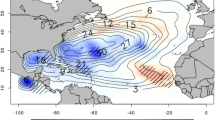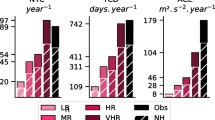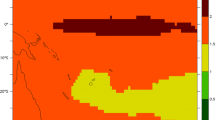Abstract
Using a suite of lateral boundary conditions, we investigate the impact of domain size and boundary conditions on the Atlantic tropical cyclone and african easterly Wave activity simulated by a regional climate model. Irrespective of boundary conditions, simulations closest to observed climatology are obtained using a domain covering both the entire tropical Atlantic and northern African region. There is a clear degradation when the high-resolution model domain is diminished to cover only part of the African continent or only the tropical Atlantic. This is found to be the result of biases in the boundary data, which for the smaller domains, have a large impact on TC activity. In this series of simulations, the large-scale Atlantic atmospheric environment appears to be the primary control on simulated TC activity. Weaker wave activity is usually accompanied by a shift in cyclogenesis location, from the MDR to the subtropics. All ERA40-driven integrations manage to capture the observed interannual variability and to reproduce most of the upward trend in tropical cyclone activity observed during that period. When driven by low-resolution global climate model (GCM) integrations, the regional climate model captures interannual variability (albeit with lower correlation coefficients) only if tropical cyclones form in sufficient numbers in the main development region. However, all GCM-driven integrations fail to capture the upward trend in Atlantic tropical cyclone activity. In most integrations, variations in Atlantic tropical cyclone activity appear uncorrelated with variations in African easterly wave activity.













Similar content being viewed by others
Notes
Available online at http://www.nhc.noaa.gov/pastall.shtml.
The TC activity in the two low-resolution GCM simulations is quite poor and is not included here. The interested reader is referred to Caron et al. (2010).
Given that the map of the mean index is nearly indistinguishable from one ensemble member to the other, we show only one map for BIGLAMERA and BIGLAMGEM2d. We have also included the climatological ASO values, since it is during this three-month period that most of the TCs occur in the Atlantic, both in observations and simulations.
Although not technically exact, for simplicity we will, henceforth, refer to this region as the western Sahel.
Here, we also include two 28-year simulations performed with the smallest grid and using slightly different versions of GEM. One version uses an alternate surface flux formulation, based on Moon et al. (2007), while in the second, we also modified the threshold value required to initiate deep convection in the Kain–Fritsch convective parametrization scheme. Basic results were not significantly affected and the two simulations are used only to increase the ensemble size.
The strongest storms are those for which the lifetime-maximum intensity is located above the 90th percentile, based on the modified wind speed, for any given year.
Ideally, we would have performed additional simulations with climatological SSTs using the larger grid, but the computer resources available did not allow it.
References
Adler RF, Huffman GJ, Bolvin DT, Curtis S, Nelkin EJ (2000) Tropical rainfall distributions determined using TRMM combined with other satellite and raingauge information. J Appl Meteorol 39:2007–2023
Aiyyer AR, Thorncroft C (2006) Climatology of vertical wind shear over the tropical Atlantic. J Clim 19:2969–2983
Andersson E, Bauer P, Beljaars A, Chevallier F, Hólm E et al (2005) Assimilation and modeling of the atmospheric hydrological cycle in the ECMWF forecasting system. Bull Am Meteorol Soc 86:387–402
Avila LA, Pasch RJ (1995) Atlantic tropical systems of 1993. Mon Weather Rev 123:887–896
Bélair S, Mailhot J, Strapp JW, MacPherson JI (1999) An examination of local versus nonlocal aspects of a TKE-based boundary layer scheme in clear convective conditions. J Appl Meteorol 38:1499–1518
Bélair S, Crevier L-P, Mailhot J, Bilodeau B, Delage Y (2003) Operational implementation of the ISBA land surface scheme in the Canadian regional weather forecast model. Part I: warm season results. J Hydrometeorol 4:352–370
Bélair S, Mailhot J, Girard C, Vaillancourt P (2005) Boundary layer and shallow cumulus clouds in a medium-range forecast of a large-scale weather system. Mon Weather Rev 133:1938–1959
Bougeault P, Lacarrère P (1989) Parameterization of orography-induced turbulence in a mesobeta-scale model. Mon Weather Rev 117:1872–1890
Burpee RW (1972) The origin and structure of easterly waves in the lower troposphere of North Africa. J Atmos Sci 29:77–90
Côté J, Gravel S, Methot A, Patoine A, Roch M, Staniforth A (1998) The operational CMC/MRB Global Environmental Multiscale (GEM) model: part I—design considerations and formulation. Mon Weather Rev 126:1373–1395
Camargo SJ, Sobel AH, Barnston AG, Emanuel KA (2007) Tropical cyclone genesis potential index in climate models. Tellus 59:428–443. doi:10.1111/j.1600-0870.2007.00238.x
Camargo SJ, Emanuel KA, Sobel AH (2007) Use of a genesis potential index to diagnose ENSO effects on tropical cyclone genesis. J Clim 20:4819–4834
Caron L-P, Jones CG, Winger K (2010) Impact of resolution and downscaling technique in simulating recent Atlantic tropical cyclone activity. Clim Dyn doi:10.1007/s00382-010-0846-7
Chauvin F, Royer JF, Douville H (2005) Interannual variability and predictability of African easterly waves in a GCM. Clim Dyn 24:523–544
Davies HC (1976) A lateral boundary formulation for multi-level prediction models. Q J R Meteorol Soc 93:1–17
Diedhiou A, Janicot S, Viltard A, de Felice P, Laurent H (1999) Easterly wave regimes and associated convection over West Africa and tropical Atlantic: results from the NCEP/NCAR and ECMWF reanalyses. Clim Dyn 15:795–822
Dunkerton TJ, Montgomery MT, Wang Z (2009) Tropical cyclogenesis in a tropical wave critical layer: easterly waves. Atmos Chem Phys 9:5587–5646
Elsner JB, Kossin JP, Jagger TH (2008) The increasing intensity of the strongest tropical cyclones. Nature 455:92–95
Emanuel KA (2005) Increasing destructiveness of tropical cyclones over the past 30 years. Nature 326:686–688
Emanuel KA, Nolan D (2004) Tropical cyclone activity and global climate. In: 26th Conference on hurricanes and tropical meteorology, pp 240–241. American Meteorol Society, Miami
Fink AH, Schrage JM, Kotthaus S (2010) On the potential causes of the non-stationary correlations between West African precipitation and Atlantic hurricane activity. J Clim 23:5437–5456
Frank WM, Ritchie EA (2001) Effects of vertical wind shear on the intensity and structure of numerically simulated hurricanes. Mon Weather Rev 129:2249–2269
Gleckler P (1996) Atmospheric model intercomparison project newsletter. No. 8, PCMDI/LLNL Available online at http://www.pcmdi.llnl.gov/projects/amip/NEWS
Goldenberg SB, Shapiro LJ (1996) Physical mechanism for the association of El Niño and West African rainfall with Atlantic major hurricane activity. J Clim 9:1169–1187
Gray W (1994) Early August updated forecast of Atlantic seasonal hurricane activity for 1994, 24 pp. Available from Department of Atmospheric Science, Colorado State University, Fort Collins
Hopsch SB, Thorncroft CD, Tyle KR (2007) Analysis of African easterly wave structures and their role in influencing tropical cyclogenesis. Mon Weather Rev 138:1399–1419
Hopsch SB, Thorncroft CD, Tyle KR (2010) Analysis of African easterly wave structures and their role in influencing tropical cyclogenesis. Mon Weather Rev 128:1399–1419
Hsieh JS, Cook KH (2005) Generation of African easterly wave disturbances: relationship to the African easterly jet. Mon Weather Rev 133:1311–1327
Hsieh JS, Cook KH (2008) On the instability of the African easterly jet and the generation of African waves: reversals of the potential vorticity gradient. J Atmos Sci 65:2130–2151
Kain JS, Fritsch JM (1990) A one-dimensional entraining/detraining plume model and application in convective parameterization. J Atmos Sci 47:2784–2802
Knutson TR, Sirutis JJ, Garner ST, Held IM, Tuleya RE (2007) Simulation of the recent multidecadal increase of Atlantic hurricane activity using an 18-km-grid regional model. Bull Am Meteorol Soc 88:1549–1565
Kuo HL (1965) On formation and intensification of tropical cyclones through latent heat release by cumulus convection. J Atmos Sci 22:40–63
Landsea CW (1993) A climatology of intense (or major) Atlantic hurricanes. Mon Weather Rev 121:1703–1713
Landsea CW, Gray WM (1992) The strong association between western Sahel monsoon rainfall and intense Atlantic hurricanes. J Clim 5:435–453
Laprise R (2008) Regional climate modelling. J Comput Phys (upon invitation), Special issue on Predict Weather Clim Extrem Events 227:3641–3666
Larow TE, Lim Y-K, Shin DW, Chassignet EP, Cocke S (2008) Atlantic Basin seasonal hurricane simulations. J Clim 21:3191–3206
Li J, Barker HW (2005) A radiation algorithm with correlated-k distribution. Part I: local thermal equilibrium. J Atmos Sci 62:286–309
McFarlane NA (1987) The effect of orographically excited gravity- wave drag on the circulation of the lower stratosphere and troposphere. J Atmos Sci 44:1175–1800
Mekonnen A, Thorncroft CD, Aiyyer AR (2006) Analysis of convection and its association with African easterly waves. J Clim 19:5405–5421
Moon I-J, Ginis I, Hara T, Thomas B (2007) A physic-based parameterization of air-sea momentum flux at high wind speeds and its impact on hurricane intensity predictions. Mon Weather Rev 135:2869–2878
Moustaoui M, Royer JF, Chauvin F (2002) African easterly wave activity in a variable resolution GCM. Clim Dyn 19:289–301
Murakami H, Wang B (2010) Future change of North Atlantic tropical cyclone tracks: projection by a 20-km-mesh global atmospheric model. J Clim 23:2699–2721
Pytharoulis I, Thorncroft C (1999) The low-level structure of African easterly waves in 1995. Mon Weather Rev 127:2266–2280
Reed RJ (1978) The structure and behaviour of easterly waves over West Africa and the Atlantic. In: Shaw DB (eds) Meteorology over the tropical oceans. Royal Meteorological Society, Bracknell, pp 57–71
Reed RJ, Norquist DC, Recker EE (1977) The structure and properties of African easterly wave disturbances as observed during Phase III of GATE. Mon Weather Rev 105:317–333
Reed RJ, Klinker E, Hollingsworth A (1988) The structure and characteristics of African easterly wave disturbances as determined from the ECMWF operational analysis/forecast system. Meteorol Atmos Phys 38:22–33
Ross RS, Krisnamurti TN (2007) Low-level African easterly wave activity and its relationship to Atlantic tropical cyclogenesis in 2001. Mon Weather Rev 135:3950–3964
Ruti PM, Dell’ Aquila A (2010) The twentieth century African easterly waves in reanalysis systems and IPCC simulations, from intra-seasonal to inter-annual variability. Clim Dyn 35:1099–1117
Simmons AJ, Burridge M (1981) An energy and angular-momentum conserving finite-difference scheme and hybrid vertical coordinates. Mon Weather Rev 109:758–766
Sundqvist H, Berge E, Kristjansson JE (1989) Condensation and cloud parameterization studies with a mesoscale numerical weather prediction model. Mon Weather Rev 117:1641–1657
Thorncroft C, Hodges K (2001) African easterly wave variability and its relationship to Atlantic tropical cyclone activity. J Clim 14:1166–1179
Thorncroft CD, Hoskins BJ (1994a) An idealized study of African easterly waves. Part I: a linear view. Q J R Meteorol Soc 120:953–982
Thorncroft CD, Hoskins BJ (1994b) An idealized study of African easterly waves. Part II: a nonlinear view. Q J R Meteorol Soc 120:983–1015
Thorncroft CD, Hall NMJ, Kiladis GN (2008) Three-dimensional structure and dynamics of African easterly waves. Part III: genesis. J Atmos Sci 65:3596–3607
Uppala SM, Ilberg PW, Simmons AJ, Andrae U, Da Costa Bechtold V et al (2005) The ERA-40 reanalysis. Q J R Meteorol Soc 131:2961–3012
Walsh KJE, Fiorino M, Landsea CW, McInnes KL (2007) Objectively determined resolution-dependent threshold criteria for the detection of tropical cyclones in climate models and reanalysis. J Clim 20:2307–2314
Walsh KJE, Sandery P, Brassington GB, Entel M, Siegenthaler-LeDrian C, Kepert J, Darbyshire R (2009) Constraints on exchange coefficients in tropical cyclones at extreme wind speeds. J Geophys Res (Oceans) 115:C09007. doi:10.1029/2009JC005876
Zadra A, Roch M, Laroche S, Charron M (2003) The subgrid scale orographic blocking parameterization of the GEM model. Atmos Ocean 41:155–170
Zadra A, Caya D, Côté J, Dugas B, Jones C, Laprise R, Winger K, Caron L-P (2008) The next Canadian regional climate model. Phys Can 64:75–83
Zhao M, Held IM, Lin S-J, Vecchi GA (2009) Simulations of global hurricane climatology, interannual variability and response to global warming using a 50 km resolution GCM. J Clim 33:6653–6678
Acknowledgments
The authors would like to thank ECMWF for making the ERA-40 and ERA-Interim reanalyses available and the National Hurricane Center for the use of their tropical cyclone best track data (HURDAT). The authors are also grateful to Kerry Emanuel for making the MPI FORTRAN routine available and to Bernard Dugas, Katja Winger and Grigory Nikulin for their help at different stages of this projet. This research was supported by the Natural Sciences and Engineering Research Council of Canada and the Mathematics of Information Technology and Complex Systems (MITACS, grant number 61851). The first author would like to thank Katherine Barrett for her help in proofreading this document. Finally, we would also like to thank two anonymous reviewers for suggesting improvements to the original manuscript.
Author information
Authors and Affiliations
Corresponding author
Rights and permissions
About this article
Cite this article
Caron, LP., Jones, C.G. Understanding and simulating the link between African easterly waves and Atlantic tropical cyclones using a regional climate model: the role of domain size and lateral boundary conditions. Clim Dyn 39, 113–135 (2012). https://doi.org/10.1007/s00382-011-1160-8
Received:
Accepted:
Published:
Issue Date:
DOI: https://doi.org/10.1007/s00382-011-1160-8




